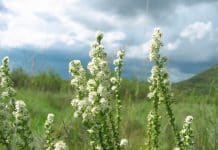
Estimated reading time: 6 minutes
Tattie Scholtz breeds Savanna goats in the Griekwastad area and is chairperson of the Savanna Club of South Africa. When talking with him you are first struck by his enthusiasm for the breed and later, once you have done the math and checked the facts, you realise that there’s more to this breed than just talk.
Tattie says Lubbe Cilliers originally bred the Savanna from indigenous veld goats in the Douglas area. The goats are mainly found in the Northern Cape, although they are also bred in the Eastern Cape and Namibia. Smaller numbers of Savannas can also be found in other parts of the country, but the value of this breed has not yet been fully realised.
“There is a lot of interest in Savanna goats from Uganda, Kenya, Senegal and Malaysia, and we have already started exporting to those countries. The Savanna is a hardy and adaptable indigenous breed, and its pigmentation protects it against the fierce African sun. Because of their loose skin, these goats also have good tick resistance.”
Weekend farmer to stud breeder
Savannas are known for their excellent maternal traits. Tattie says this is what has piqued his interest in the breed since school. He has always dreamt of being a farmer.
“In my matric year in 1999 I used my savings and bought a few ewes with lambs. The goats’ beautiful, uniform white colour caught my eye. I eventually started farming on the farm Spoedaan in the Griekwastad district. In 2002, I bought the farm with the encouragement and help of my good friend Mattie Lotter. That’s when I started farming full time. My focus is mainly on sheep farming, but I have a soft spot for the Savanna,” he says.
As he was initially unable to be on the farm full time, he had to buy animals that could take care of their lambs under extensive conditions. “The animals were at the mercy of the elements and predators, and the Savannas have impressed me time and again with their good lambing and weaning percentages. Through rigorous selection our breeders managed to breed ewes with good teats and udders, which is why they have enough milk to raise their lambs without much effort.”
It is easy to farm Savanna goats, he explains. “The Savanna has the same eating habits as other goats. However, they can trek long distances in search of grazing, move easily and love to graze in a herd. The goats thrive on any terrain and can handle drought conditions well. Because of their white skin, the breed is also popular for religious reasons, especially during certain times of the year and particularly in KwaZulu-Natal.”

Teamwork and selection pay off
“Our whole family is involved in the farming enterprise. My wife, Yolandi, is my biggest supporter. She does the administrative work and makes sure the books balance. Our children Ané (11), Armand (9) and Anandi (4) also happily share in the farm work and love the Savannas just as much as I do. I also have an excellent team of workers, each of whom is responsible for a division of the farming enterprise, from animal health and care to the maintenance of infrastructure.”
The Scholtz family spends as much time as possible tending to the goats to keep the animals healthy and well cared for. “Only the best rams are used for breeding, and we only select the best progeny according to breed standards.
“For the past few years we have also been involved in a veld ram project. The animals are put through a strict process and are eventually evaluated so that the numbers and growth ability of a controlled group can be studied. During shows we constantly measure our animals against those of other breeders, which leads to good marketing and publicity,” says Tattie enthusiastically.
Management and planning
Tattie farms his goats extensively and the season determines which lick and supplements the goats receive. He has two lambing seasons. Mating commences mid-October and the ewes lamb for six weeks starting 15 March. The next group is mated from mid-April and lambs from mid-September. The reason for the two lambing seasons is to allow the kids to escape the worst cold. Tattie’s lambing percentage of 180 to 190% under these extensive conditions makes this a very productive endeavour.
He says the ewes are fed a good production lick during gestation. Four weeks before lambing the ewes are moved to 50ha camps that are closer to home in order to simplify management. “The necessary vaccinations are administered and once the ewes start to lamb, they are examined in the mornings and evenings to make sure there are no problems. The lambs are marked as soon as they arrive, and all information is recorded to facilitate good recordkeeping.”
Depending on the season, lambs are weaned as soon as they weigh between 15 and 20kg. After approximately four to five months, the kids are classed and sorted for sale. “We market about two to three times a year to secure the best possible prices. The price for young kids varies tremendously and is linked mainly to markets in KwaZulu-Natal. Although a roller mark for goat meat has been registered, the meat is not freely available due to limited numbers. This remains a challenge, and I believe goat farmers will benefit if this changes,” he says.
Exciting plans for the gene pool
Tattie started the Savanna stud in 2014. After his animals were inspected and vetted by breed experts, he bought in better genetics from other breeders to expand the stud. He says they maintain a broad gene pool within the stud, which they use for breeding purposes and to expand the stud even further.

Tattie is excited about the opportunities that goat exports offer and says there is great interest in Savannas, especially from African countries where these goats thrive. His key goal for the future is to produce good-quality Savannas for the market according to the breed standards.
Read more about the goat meat industry.
“Although there are many white goats, there aren’t many pure Savannas. Breeding and selling good-quality animals will expand the Savanna gene pool. The demand for quality breeding material is currently high, both locally and internationally, and if you do proper marketing, you can get a premium for the Savanna,” he concludes.
For more information, phone Tattie Scholtz on 082 493 6306. – Koos du Pisanie, Stockfarm








